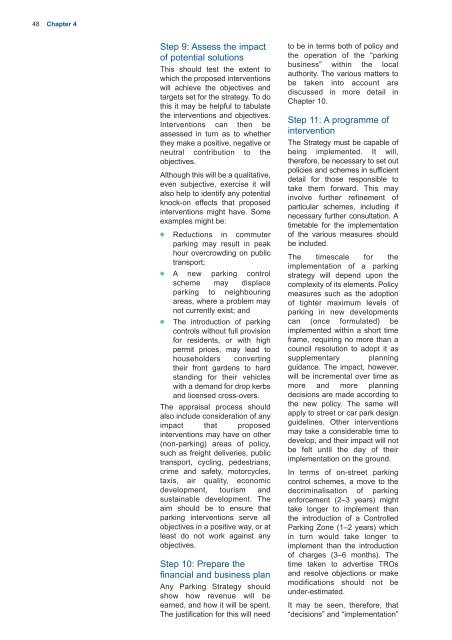titlepage/contents pg 1-16 - British Parking Association
titlepage/contents pg 1-16 - British Parking Association
titlepage/contents pg 1-16 - British Parking Association
Create successful ePaper yourself
Turn your PDF publications into a flip-book with our unique Google optimized e-Paper software.
48 Chapter 4Step 9: Assess the impactof potential solutionsThis should test the extent towhich the proposed interventionswill achieve the objectives andtargets set for the strategy. To dothis it may be helpful to tabulatethe interventions and objectives.Interventions can then beassessed in turn as to whetherthey make a positive, negative orneutral contribution to theobjectives.Although this will be a qualitative,even subjective, exercise it willalso help to identify any potentialknock-on effects that proposedinterventions might have. Someexamples might be:● Reductions in commuterparking may result in peakhour overcrowding on publictransport;● A new parking controlscheme may displaceparking to neighbouringareas, where a problem maynot currently exist; and● The introduction of parkingcontrols without full provisionfor residents, or with highpermit prices, may lead tohouseholders convertingtheir front gardens to hardstanding for their vehicleswith a demand for drop kerbsand licensed cross-overs.The appraisal process shouldalso include consideration of anyimpact that proposedinterventions may have on other(non-parking) areas of policy,such as freight deliveries, publictransport, cycling, pedestrians,crime and safety, motorcycles,taxis, air quality, economicdevelopment, tourism andsustainable development. Theaim should be to ensure thatparking interventions serve allobjectives in a positive way, or atleast do not work against anyobjectives.Step 10: Prepare thefinancial and business planAny <strong>Parking</strong> Strategy shouldshow how revenue will beearned, and how it will be spent.The justification for this will needto be in terms both of policy andthe operation of the “parkingbusiness” within the localauthority. The various matters tobe taken into account arediscussed in more detail inChapter 10.Step 11: A programme ofinterventionThe Strategy must be capable ofbeing implemented. It will,therefore, be necessary to set outpolicies and schemes in sufficientdetail for those responsible totake them forward. This mayinvolve further refinement ofparticular schemes, including ifnecessary further consultation. Atimetable for the implementationof the various measures shouldbe included.The timescale for theimplementation of a parkingstrategy will depend upon thecomplexity of its elements. Policymeasures such as the adoptionof tighter maximum levels ofparking in new developmentscan (once formulated) beimplemented within a short timeframe, requiring no more than acouncil resolution to adopt it assupplementary planningguidance. The impact, however,will be incremental over time asmore and more planningdecisions are made according tothe new policy. The same willapply to street or car park designguidelines. Other interventionsmay take a considerable time todevelop, and their impact will notbe felt until the day of theirimplementation on the ground.In terms of on-street parkingcontrol schemes, a move to thedecriminalisation of parkingenforcement (2–3 years) mighttake longer to implement thanthe introduction of a Controlled<strong>Parking</strong> Zone (1–2 years) whichin turn would take longer toimplement than the introductionof charges (3–6 months). Thetime taken to advertise TROsand resolve objections or makemodifications should not beunder-estimated.It may be seen, therefore, that“decisions” and “implementation”







